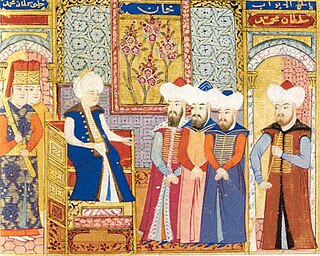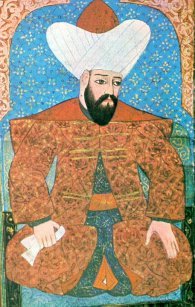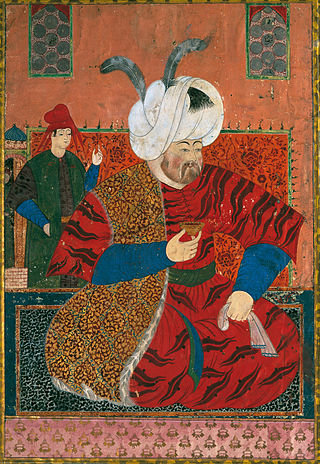
Ahmed I was sultan of the Ottoman Empire from 1603 to his death. Ahmed's reign is noteworthy for marking the first breach in the Ottoman tradition of royal fratricide; henceforth, Ottoman rulers would no longer systematically execute their brothers upon accession to the throne. He is also well known for his construction of the Blue Mosque, one of the most famous mosques in Turkey.

Bursa is a city in northwestern Turkey and the administrative center of Bursa Province. The fourth-most populous city in Turkey and second-most populous in the Marmara Region, Bursa is one of the industrial centers of the country. Most of Turkey's automotive production takes place in Bursa.

Murad I was the Ottoman Sultan from 1362 to 1389. He was the son of Orhan Gazi and Nilüfer Hatun. Murad I came into the throne after his elder brother Süleyman Pasha's death.

Mehmed I, also known as Mehmed Çelebi or Kirişçi, was the Ottoman sultan from 1413 to 1421. The fourth son of Sultan Bayezid I and Devlet Hatun, he fought with his brothers over control of the Ottoman realm in the Ottoman Interregnum (1402–1413). Starting from the province of Rûm he managed to bring first Anatolia and then the European territories (Rumelia) under his control, reuniting the Ottoman state by 1413, and ruling it until his death in 1421. Called "The Restorer," he reestablished central authority in Anatolia, and he expanded the Ottoman presence in Europe by the conquest of Wallachia in 1415. Venice destroyed his fleet off Gallipoli in 1416 as the Ottomans lost a naval war.

Murad II was the sultan of the Ottoman Empire from 1421 to 1444 and again from 1446 to 1451.

Osman I or Osman Ghazi, sometimes transliterated archaically as Othman, was the founder of the Ottoman Empire. While initially a small Turkoman principality during Osman's lifetime, his beylik transformed into a world empire in the centuries after his death. It existed until shortly after the end of World War I.

Orhan Ghazi was the second bey of the Ottoman Beylik from 1323/4 to 1362. He was born in Söğüt, as the son of Osman I.

Selim II, also known as Selim the Blond or Selim the Drunk, was the Sultan of the Ottoman Empire from 1566 until his death in 1574. He was a son of Suleiman the Magnificent and his wife Hurrem Sultan. Selim had been an unlikely candidate for the throne until his brother Mehmed died of smallpox, his half-brother Mustafa was strangled to death by the order of his father, his brother Cihangir succumbed to chronic health issues, and his brother Bayezid was killed on the order of his father after a rebellion against Selim. Selim died on 15 December 1574 and was buried in Hagia Sophia.

The rise of the Ottoman Empire is a period of history that started with the emergence of the Ottoman principality in c. 1299, and ended circa 1453. This period witnessed the foundation of a political entity ruled by the Ottoman Dynasty in the northwestern Anatolian region of Bithynia, and its transformation from a small principality on the Byzantine frontier into an empire spanning the Balkans, Anatolia, Middle East and North Africa. For this reason, this period in the empire's history has been described as the "Proto-Imperial Era". Throughout most of this period, the Ottomans were merely one of many competing states in the region, and relied upon the support of local warlords Ghazis and vassals (Beys) to maintain control over their realm. By the middle of the fifteenth century the Ottoman sultans were able to accumulate enough personal power and authority to establish a centralized imperial state, a process which was brought to fruition by Sultan Mehmed II. The conquest of Constantinople in 1453 is seen as the symbolic moment when the emerging Ottoman state shifted from a mere principality into an empire therefore marking a major turning point in its history.

Osmangazi is a municipality and district of Bursa Province, Turkey. Its area is 621 km2, and its population is 891,250 (2022). It is one of the central metropolitan districts of the city of Bursa, as well as the fourth largest overall municipality in Turkey. On its own, it would be the 28th largest city in Turkey.

The siege of Nicaea by the forces of Orhan I from 1328 to 1331, resulted in the conquest of a key Byzantine Greek city by the Ottoman Turks. It played an important role in the expansion of the Ottoman Empire.
After its foundation by Osman I in about 1299, the Ottoman Empire expanded across Bithynia in north-west Anatolia by capturing territory from the Byzantine Empire. Osman was succeeded by his son Orhan in about 1324 and, following long sieges, he took the important cities of Bursa (1326) and Nicaea (1331). Next, Orhan besieged Nicomedia from 1333 to 1337. The Byzantine garrison surrendered due to lack of food and resources. Orhan's victory sealed Ottoman control of Bithynia.

The Battle of Pelekanon, also known by its Latinised form Battle of Pelecanum, occurred on June 10–11, 1329 between an expeditionary force by the Byzantines led by Andronikos IIl and an Ottoman army led by Orhan I. The Byzantine army was defeated, with no further attempt made at relieving the cities in Anatolia under Ottoman siege.
Alaeddin Pasha, or Alaeddin Bey, was the brother of Orhan I, who succeeded their father, Osman I, in the leadership of the Ottoman Empire. His mother was Rabia Bala Hatun, daughter of Sheykh Edebali. It is not certain whether Alaeddin or Orhan was the elder son. Some historians claim that Alaeddin was Osman's second son, but others argue that there is a good chance that he was the oldest. Nevertheless, Orhan ruled the country and became the first Ottoman ruler to take the title of Sultan. According to tradition and Ottoman historiography as presented by historian Idris Bitlisi, Alaeddin was more passive than his warrior brother, and thus stayed at home instead of fighting to expand the newly forming Ottoman Empire. He received training in the management of the state affairs. There is a good chance that Orhan was selected to inherit leadership of the Empire because of his skills as a warrior.

Nilüfer Hatun, was a concubine of Orhan, the second Ottoman sultan, and the mother of Murad I, Orhan's successor.
Ali Bey Evrenosoğlu or Evrenosoğlu Ali Bey, known simply as Ali Bey, was an Ottoman military commander in the 15th century. He was one of the sons of Evrenos, an Ottoman general. During the 1430s he was sanjak-bey of the Sanjak of Albania who, after initial defeats, suppressed the Albanian Revolt of 1432–1436 with help of the forces commanded by Turahan Bey. In 1440 he participated in the unsuccessful Ottoman Siege of Belgrade.

The following is a timeline of the history of the city of Bursa, Turkey.

Turgut Alp was one of the warriors and alps who fought for Ertuğrul, a Turkoman leader and bey, and Ertuğrul's son Osman I, the founder of the Ottoman Empire. After the establishment of the Empire, he became one of its military commanders, serving Osman I, as well as his son, Orhan Gazi.
The Siege of Kulaca Hisar or Raid of Kulaca Hisar was a battle fought between the Byzantines and the Turks under the command of Osman Gazi in 1285.















